Each watch is exactingly unique by its original movement and mechanisms since each new collection must, each time, be a totally exclus-ive ‘world first’. It is like a work of art because each watch in each collection possesses its own dial, which is never repeated. There are no two Jean Dunand timepieces that are alike.
This exclusive strategy is quite unique in the watch industry. Other brands make ‘unique’ watches but no one makes only unique pieces as does Jean Dunand. This is a mandate that the brand’s two creators, Thierry Oulevay and Christophe Claret, themselves, call “going right up to the top” since it is so strict and demanding. Above and beyond their technical innovation and their aesthetic singularity, each piece must also be finished to the extreme, utilizing the skills of the industry’s most talented artisans and watchmakers.
With these kinds of demands for excellence, and knowing that each time the watch will be a world first, we can easily imagine that it takes a great deal of time to create and produce these pieces. In fact, one collection is released only every two years.
The Jean Dunand adventure began with the Tourbillon Orbital, introduced in 2005, after nearly five years of research and development. In 2007, it presented the Shabaka. In the meantime, Jean Dunand also created and produced a series strictly limited to six pieces—a Grande Complication that takes its place among the most complicated timekeepers in the world (827 component parts and six months of work for each piece).
Timekeeping art and Art DÉco
Besides the criteria of uniqueness, Jean Dunand also proposes a totally original and particular approach to watchmaking that emanates directly from the personality of its creators, Thierry Oulevay and Christophe Claret.
Christophe Claret, well known in the watch arena, is one of the most talented and inno-vative watchmakers of his generation. At the head of his own company, he works for some of the largest Swiss brands, for which he designs and produces exceptional and complex movements. Yet, it is with Jean Dunand that he allows himself to freely express what he is particularly known for—his true genius in three-dimensional mechanics.
Thierry Oulevay is a proven watch entrepreneur who gained experience at Piaget, after which he re-created the historic brand Bovet that he left in 2001, the year he met Christophe Claret. An aficionado of Art DÉco and a huge connoisseur of artisanal skills and crafts, he provides the Jean Dunand pieces with their original aesthetic inspiration, which also accounts for a large part of their price. This is because, rather than mildly reproducing the style of Art DÉco watches of the epoch, the goal of the unique pieces of Jean Dunand is to capture its spirit and essence—simple but affirmed geometry, functional design, the use of material that is as precious as it is surprising or rare, and the valorisation of craftsmanship.
Bringing together the best of its era
The perfect complementarities of these qualities, both technical and aesthetic, have given birth to a surprising, singular, and striking type of timekeeping. It is a form of art that is unlike any other. It is a watchmaking that succeeds in bringing together the best of its era, both in terms of its advanced technical innovation in contemporary mechanical watchmaking, as well as its determination to revive the most precious of artisanal crafts, such as enamelling, miniature painting, lacquer work, and jewellery setting, that are placed in the service of the Unique Pieces of Jean Dunand.
Inventive, Jean Dunand has also been innovative for the watch industry as a whole. The brand is a precursor of one of the strongest trends we are seeing in the industry at the current time—the search for absolute exclusivity. (See our article ‘The Über watches’ in this issue, in which we analyze this trend in more detail, and return notably to Jean Dunand.)
For Thierry Oulevay, “the exclusivity of the Unique Pieces of Jean Dunand is not an end in itself or a marketing strategy. It is the natural result of our determination to propose timepieces that compete with or surpass the best of Swiss production, as much by their technical design as by the quality of the workmanship.”
It thus goes without saying that this level of demanding excellence “is inseparable from an exclusive and greatly limited production.” It is a production that counts in tens of pieces, so its distribution network is strictly made up of a few exclusive re-sellers, chosen for their willingness and their ability to be true partners of the brand, and capable of transmitting in an understandable manner the technical and design qualities that form the intrinsic value of each unique piece.
TOURBILLON ORBITAL
The Tourbillon Orbital, the first of the JEAN DUNAND PiÈces Uniques and an achievement never before seen in watchmaking, features a one minute flying tourbillon that orbits the dial once an hour on a revolving movement. The watch also introduces a novel power-reserve indicator in the caseband, provides a new view of the movement and displays the phases of the moon on the caseback.
The patented Io 200 movement (named after Jupiter’s moon) constructed by Christophe Claret confounded Claret’s fellow watchmakers who thought that an orbiting tourbillon was impossible to realize. Furthermore, it returns the tourbillon to its original role as a precision device. Timing tests show that the combined rotation of the tourbillon and the movement significantly improves the rate stability of the watch.
Wheels within wheels
The barrel and the flying tourbillon (set opposite each other) orbit the centre, sandwiched between two plates held apart by pillars and rotating on ball bearings. The top plate constitutes the revolving dial, with an aperture to reveal the tourbillon. The tourbillon has been raised as much as possible to make it more easily seen.
The barrel unwinds against a central fixed pinion, driving itself and the tourbillon around. The tourbillon escapement regulates the speed of rotation. As it orbits, the tourbillon cage rotates once a minute against a fixed circumference wheel through a train of wheels. This configuration reduces the number of jewel bearings to 14, substantially cutting friction.
How to wind and set a rotating movement
It took Christophe Claret two years to work out the mechanical solutions to winding and setting a rotating movement with a mainspring barrel that never stays in one place. The conventional crown through the caseband is obviously impossible.
The solution of winding and setting the movement vertically through its central axis is new to watchmaking. A folding key set into the caseback replaces the crown. Lifting the D-ring of the key engages a central wheel on ball bearings that turns the ratchet-wheel to wind the barrel-spring. Pulling out the key connects the motion work of the hour and minute hands to set them in any direction. Set against the fixed chapter ring, the minute hand turns with the rotating dial.
Windows to the heart of the movement
The winding key and the moon-phase display on the back of the watch prevent a conventional view of the rotating movement through a sapphire-crystal caseback. But the absence of the usual crown at 3 o’clock allowed the casemakers to provide a fascinating lateral view of the revolving mechanisms by cutting two windows in the caseband.
A power-reserve indicator never seen before
The side windows opened the opportunity for another first in watchmaking: an entirely original way of indicating the power reserve. The window at 3 o’clock displays a vertical needle that moves between F (full) and E (empty) like the fuel gauges in vintage cars. The secret of indicating the power-reserve in one place from a constantly moving barrel is patented.
A series of stunning dials
The dial materials include gold, black opal, rare hardstones, fossils, ruby heart, fossilized anaconda and Dalmatian jasper. Not only are the selected stones rare in themselves, but they also have to be large enough to be transformed into 3cm-diameter dials. The case is in rose gold, white gold, or platinum with matching buckle.
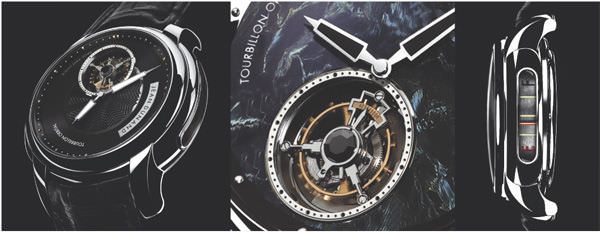
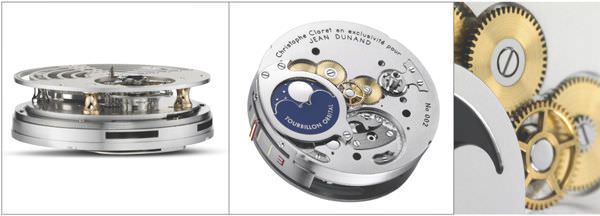
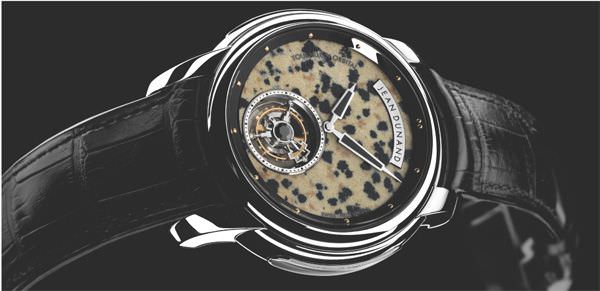
SHABAKA
The Shabaka is a feat of micro-engineering complexity - a minute-repeater on cathedral gongs and an instantaneous perpetual calendar with a unique display of the dates, phases of the moon and leap-year cycle, as well as an ingenious state-of-wind indicator.
Calendar indications
The originality of this impressive timepiece is in the calendar indications on four cylinders instead of the conventional discs. These are rotated by four different 90-degree transmission systems, each fitted with a security device to ensure precise calendar changes. Furthermore, unlike in most calendar indications, the dates (two digits on separate cylinders), days, and months jump instantaneously at midnight, when a sprung mechanism is released.
The indication of the leap-year cycle is also novel: a white plate under the dial illuminates in turn the letter B (for bissextile) and the three ordinary years cut out on the dial between 7 and 8 o’clock. The leap year is mirrored by the phases of the moon for which black discs travel over the surface of the moon like the shadow of the earth, eclipsing it to the left as it wanes, and revealing it from the right as it waxes.
The mechanical moon deviates from the real moon by only one day every 120 years.
For all the complexity of the calendar indications, the state-of-wind indicator on the back of the watch is absurdly simple yet equally original. A single moving part - the mainspring itself in an open barrel - shows the power reserve of the watch against a scale.
Minute repeater
The minute repeater strikes on two cathedral gongs that go twice around the movement to give a deeper and more resonant chime. The minute-repeater slide on the left of the case means that the calendar setting controls are on the right. Two chronograph-style pushers are used to set the entire calendar (the gold pusher at 4 o’clock) and the days only (at 2 o’clock). A pushpiece set coaxially in the crown advances the months and years, while the moon is set by a pushpiece in the caseband at 5 o’clock.
A complex series of levers reaches around the movement from the pushers to activate the respective calendar indications.
The calibre is of a particular construction, with the perpetual-calendar mechanism integrated in the 13-ligne repeating movement. The 7mm diameter cylinders are embedded 2.5 millimetres into the level of the minute-repeater to reduce further the thickness of the movement.
Beautiful finish
An anthracite-black finish on the circular-grained baseplate and on the bridges decorated in concentric Geneva stripes, contrasts with burnished steel, ruby and gold to highlight the beauty of the movement presented through the caseback.
The original calendar displays are integrated into the stunning geometrical design of the dial - a superb piece of engineering on four levels composed of a nickel-alloy frame delineating fields of blackened gold set with lapped pyramids of pink gold. The red hour-markers at 10, 12 and 2 o’clock serve to indicate the day, date, and month respectively, against corresponding red triangles in the centre of the dial.
The Art DÉco-inspired design, with its Egyptian influences, is reflected in the exotic name of the watch - Shabaka, the 25th-dynasty pharaoh and king of Egypt
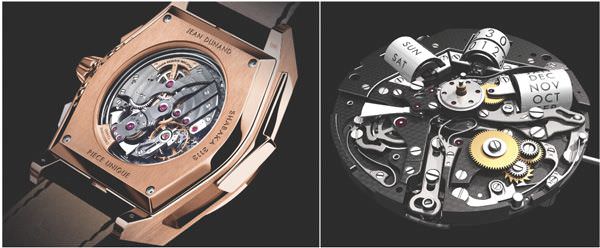
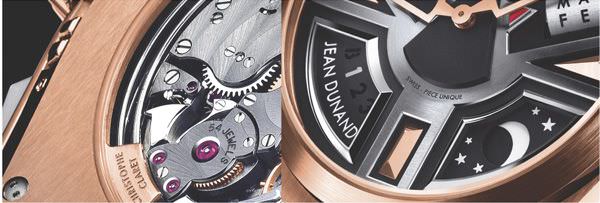
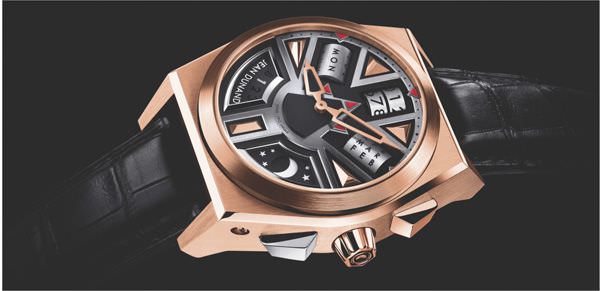
Source: Europa Star February-March 2008 Magazine Issue





